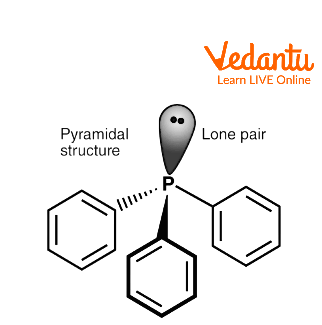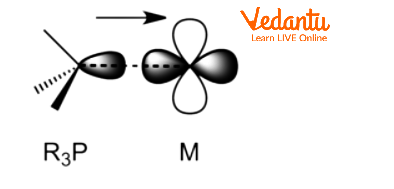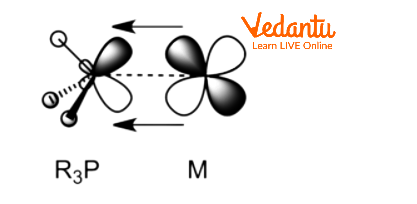




What is Triphenylphosphine
PPh3 ligand name is triphenylphosphine which is also known as triphenylphosphine (IUPAC name) is a common organophosphorus chemical compound with the formula (C6H5)3 which is most commonly used in the synthesis of organometallic and organic compounds. Due to its efficiency as a reducing agent and neutrality as a ligand, it is frequently utilised in the synthesis of organic and organometallic compounds. PPh3 crystals are largely air-stable and colourless at ambient temperature. It dissolves in non-polar chemical solvents like benzene and diethyl ether.
Structure of Triphenylphosphine
There are a total of 36 bonds in the triphenylphosphine molecule. There are 18 multiple bonds, 3 rotatable bonds, 18 aromatic bonds, 3 six-membered rings, and 1 phosphine in addition to the 21 non-H bonds. Both the triclinic and monoclinic forms are formed when triphenylphosphine crystallises. In both instances, the molecule is composed of three phenyl groups that are arranged like propellers and have a pyramidal structure.
The phosphorus atom at the centre of triphenylphosphine is sp3 hybridised. P-C sigma bond directly links the phosphorus atom to three phenyl groups, and an electron pair is present in one sp3 hybridised orbital as a lone pair.

PPh3 Structure
Properties of PPh3
Triphenylphosphine is a white crystalline solid which is odourless and largely air-stable at room temperature. It has a density of 1.1 g/cm3 and a dipole moment of 1.42D. Its polarity is very low hence it is soluble in non-polar solvents like benzene, diethyl ether, etc.
Its chemical formula is ${{({{C}_{6}}{{H}_{5}})}_{3}}P$ and its molecular mass is about 262.3 g/mol
Melting point = 80 ℃
Boiling point = 377 ℃
Solubility in water = 0.09 mg/L at 25 ℃ (insoluble in water)
Vapour pressure = 0.017 Pa at 50 ℃
It breaks down when heated, producing phosphine and phosphorus oxides; an allergen that causes irritation to the skin, eyes, and respiratory system; the powerful reducing agent that induces convulsions in lethal doses, is very harmful if consumed.
Preparation of PPh3
By treating phosphorus trichloride with phenylmagnesium bromide or phenyl lithium, triphenylphosphine can be synthesised in a laboratory. Commercial synthesis involves the reaction of sodium, chlorobenzene, and phosphorus trichloride.
$PC{{l}_{3}}\,+\,3PhCl\,+\,6Na\,\to \,PP{{h}_{3}}\,+\,6NaCl$
Reactions of Triphenylphosphine
Quaternization: Alkyl halides and $PP{{h}_{3}}$ react at elevated temperatures with the help of metal catalysts to form phosphonium salts. Benzylic and allylic halides undergo an extremely rapid quaternization process.
$PP{{h}_{3}}\,+\,C{{H}_{3}}I\,\to \,{{\left[ C{{H}_{3}}PP{{h}_{3}} \right]}^{+}}{{I}^{-}}$
Mitsunobu Reaction: A mixture of triphenylphosphine and diisopropyl azodicarboxylate ("DIAD" or its diethyl counterpart, DEAD) transforms alcohol and a carboxylic acid into an ester in the Mitsunobu reaction. The $PP{{h}_{3}}$ is oxidised to $OPP{{h}_{3}}$ and the DIAD is reduced while acting as the hydrogen acceptor.
Oxidation: Slow air oxidation of triphenylphosphine results in triphenylphosphine oxide.
$2PP{{h}_{3}}\,+\,{{O}_{2}}\,\to \,2OPP{{h}_{3}}$
Chlorination: Triphenylphosphine dichloride, which occurs as the moisture-sensitive phosphonium halide, is produced when Chlorine reacts with $PP{{h}_{3}}$. In organic synthesis, this reagent is used to transform alcohols into alkyl chlorides.
$2P{{h}_{3}}PC{{l}_{2}}\,+\,N{{H}_{2}}OH.HCl\,+\,P{{h}_{3}}P\,\to \,\left\{ {{\left[ P{{h}_{3}}P \right]}_{2}}N \right\}Cl\,+\,3HCl\,+\,P{{h}_{3}}PO$
Protonation: Being a weak base $PP{{h}_{3}}$ produces isolable triphenylphosphonium salts when combined with strong acids like HBr.
$P{{\left( {{C}_{6}}{{H}_{5}} \right)}_{3}}\,+\,HBr\,\to \,{{\left[ HP{{\left( {{C}_{6}}{{H}_{5}} \right)}_{3}} \right]}^{+}}B{{r}^{-}}$
Metal - Phosphine Complex
A coordination compound with one or more phosphine ligands is known as a metal-phosphine complex. The phosphine is almost usually an organophosphine of type ${{R}_{3}}P$ (R = alkyl, aryl). There is a vast application of metal phosphine compounds in homogeneous catalysis.
Many metal phosphine complexes are made by reacting metal halides with phosphines that have already been produced. For instance, when palladium chloride is suspended in ethanol and treated with triphenylphosphine, monomeric bis(triphenylphosphine)palladium(II) chloride units are produced.
$\left[ PdC{{l}_{2}} \right]n\,+\,2nPP{{h}_{3}}\,\to \,nPdC{{l}_{2}}{{(PP{{h}_{3}})}_{2}}$
Bonding in Metal - Phosphine Complex
Phosphines are L-type ligands which means that $PP{{h}_{3}}$ is a neutral ligand and can donate 2 electrons to the metal centre. Metal phosphine complexes often exhibit strong solubility in organic solvents and are lipophilic, when compared to the majority of metal ammine complexes. Additionally, phosphine ligands function as π -acceptors. Their π-acidity results from the overlap of P-C σ* anti-bonding orbitals with filled metal orbitals. Alkyl Phosphines are weaker π-acceptors than aryl phosphines and fluorophosphate.

${{R}_{3}}P$–M σ Bonding

${{R}_{3}}P$–M π Back Bonding
Uses of Triphenylphosphine
Making of sensitizers, heat stabilisers, light stabilisers, antioxidants, flame retardants, antistatic agents, rubber antiozonants, and analytical reagents are just a few of the uses for triphenylphosphine.
Chlorambucil, which has been demonstrated to be cytotoxic in breast and pancreatic tumours, is made using triphenylphosphine.
In the production of vitamin D2, vitamin A, clindamycin, and other medicines, triphenylphosphine is utilised.
In addition, triphenylphosphine is employed as a transition metal-ligand in the Suzuki, Mitsunobu, and Appel reactions as well as in the polymerisation of olefins and it is a standard ligand used in homogeneous catalysis.
Important Questions
Triphenylphosphine is what kind of ligand?
Ans: Triphenylphosphine is an L-type ligand which means that it is a neutral ligand and can donate 2 electrons to the metal centre. Metal phosphine complexes, in contrast to the majority of metal ammine complexes, are lipophilic and have high solubility in organic solvents.
Comment on the toxicity of triphenylphosphine.
Ans: Triphenylphosphine is a toxic compound found in nature. Our skin, respiratory system, or eyes may become irritated when it comes in contact with them.
Conclusion
Triphenylphosphine is a white crystalline solid which is odourless, cheaper and air-stable than any other phosphines. Due to its efficiency as a reducing agent and neutrality as a ligand, the Metal-Phosphine complex is frequently utilised in the synthesis of organic and organometallic compounds. It has a total of 36 bonds and a pyramidal structure. It undergoes various reactions like quaternization, mitsunobu reaction, oxidation, chlorination, and protonation reactions. It is widely used for making analytical reagents, drugs like chlorambucil, vitamins like Vitamin D2, Vitamin A, etc.
Practice Questions
A total of how many bonds are present in triphenylphosphine?
20
36
42
51
What is the structure of triphenylphosphine?
Pyramidal
Tetrahedral
Angular
Planar
Answers
(b)
(a)
FAQs on Triphenylphosphine
1. Is PPH3 a base?
The base triphenylphosphine is a weak base. Triphenylphosphonium salts are created when it is mixed with strong acid (HBr) or an alkyl halide. It is categorised as a Lewis base because it possesses a lone pair that may be transferred to another molecule. Despite being a weak base, triphenylphosphine because of its lone pair, the 'P' atom, participates in resonance with the third phenyl ring's electron. As a result, the lone pair on the phosphorus atom is less available for donation to the species that lack electrons. Thus, triphenylphosphine functions as a weak base. The triphenylphosphine pKa value is 7.64. Since it is a weak base, it makes an excellent nucleophile.
2. What are L-type ligands?
Regardless of the technique used to count the electrons, L-type ligands are neutral ligands that donate the metal centre with two electrons. Lone pairs, pi, or sigma donors may supply these electrons. Dative covalent bonds, sometimes referred to as coordinate bonds, are generated between these ligands and the metal. Triphenylphosphine is a neutral ligand in coordination chemistry, however, because of its high splitting efficiency, it is considered to be a strong field ligand. Carbenes, alkenes, ammonia, carbon monoxide, etc are some examples.
3. Write a short note on Appel's reaction.
The Appel reaction is a chemical process that uses triphenylphosphine and carbon tetrachloride to convert an alcohol into an alkyl chloride. Halogenating triphenyl-phosphine is the first step in the reaction, which is followed by the creation of alkoxide from the alcohol starting material. After attacking the phosphorus, the alkoxide releases the halide leaving group.
The final alkyl halide product with inverted stereochemistry is produced in a nucleophilic substitution process when the halide (nucleophile) attacks the carbon stereocenter. This reaction is driven by the creation of the strong P=O double bond, which results in the byproduct of triphenylphosphine oxide.











